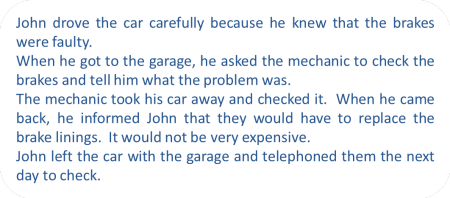Subjects and Objects: the essentials

What is the difference?
 |
In the English sentences:
we only know who did what to whom by the order of the words. The subject comes first in both sentences so we know that is the doer of
the action. |
| In sentence 1 | the man is the subject of the verb kiss | the woman is the object of the verb |
| In sentence 2 | the woman is the subject of the verb kiss | the man is the object of the verb |
Usually, of course, we can understand what is the subject and what is the object of a verb by the meaning of the sentence:
- Peter drank the water
Cannot (sensibly) be changed to:
- The water drank Peter
Here's a little test.
Identify the subjects and the objects of the verbs in this story and
then click on the story for the answers.
|
|
Notice that:
|
In grammar books, you will often see the term nominative
(case) to refer to the subject and accusative (case)
to refer to the object. Most learners of English don't
need to understand these terms (but you do).
We have now identified two of the three cases in
English (the third is the possessive or genitive which does not concern
us here).
To be sure you have all this, try identifying the subjects and
objects, if any, in the following sentences. Click on the
![]() to reveal some comments.
to reveal some comments.
|
John and his sister came to the party |
Subjects are
often noun phrases rather than simple nouns so in this,
the subject is John and his sister not just
John.
There is no object because the verb is intransitive and never takes an object. The prepositional expression to the party is an adverbial modifying the verb and telling us where the subject came. It is not the object. |
|
I enjoy swimming in the sea |
It's clear that
the subject is the first person pronoun, I, but
the object is less easy to identify. It is the
verb form (a gerund) plus its modification (not just
swimming) because in this case the
prepositional phrase is modifying the word swimming
not the verb itself. The object, therefore, is
swimming in the sea.
Nouns are often formed by add -ing to the base form of a verb but how they act in sentences is sometimes rather complicated. |
|
The man who sold me the car seemed
happy with the price |
Here again we have a complex subject of the verb
seem and it is The man who sold me the car
not just the man. Often, a noun in
English is modified (i.e., is given additional
information) by a relative pronoun clause.
The relative pronoun clause here is who sold me the
car and it defines the man. Sometimes such clauses are called adjectival clauses
because they perform the function of describing the
noun.
You may be forgiven for thinking that the price is the object of the verb seem but it isn't because the verb is not acting on it. The phrase happy with the price is an adjective-phrase complement of the verb. |
|
The door was broken open by the
thieves |
This is difficult because we have a passive clause.
The active clause:
The thieves broke open the door is simple to analyse because we have the subject (the thieves) and an object, the door. However, when a sentence is made passive like this, referring to subjects and objects is confusing. A better way to analyse the sentence is to say that the door is the patient and the thieves is the agent. |
|
That Mary was not allowed to take
the time off in June surprised everyone in the office where
she works |
This is also quite difficult because we have an extended
subject and object.
The subject is a that-clause: That Mary was not allowed to take the time off in June and the object is a modified pronouns: everyone in the office where she works Only the verb, surprised is a simple one-word phrase. |
|
She gave John the money |
Here we have a simple subject, She, but there
are two objects: the money and John.
The first of those is the direct object because we can also have: She gave the money and the sentence still makes sense. The word John is the indirect object so if we say: She gave John the sentence either makes no sense or has a very different meaning. In English we can often reverse the ordering of the objects and allow: She gave the money to John which is not something we can do in many languages. |
The point of all this is that being able to recognise subjects and object quickly is a key skill when it comes to understanding what you hear or read.
 |
Other languages do things differently |
Languages which show case structure
If you speak some German, the following will be familiar to you:
- Der Mann küsste die Frau
- Die Frau küsste den Mann
Sentences 5 and 6 are direct translations of sentences 1 and 2.
Notice, however, that there is subtle difference: the definite article
for the man changes from der to den in sentence 2.
This is because German is one of many languages which distinguishes
between cases by changing the form of words. It can also change
the form of adjectives and nouns to reflect the case. In this
example, the article for the woman is the same in both cases.
The second thing to note is that reversing the word order does
not reverse the meanings of the sentences:
- Die Frau der Mann küsste
- Den Mann die Frau küsste
A German speaker might be mildly surprised by the word-order change but under no illusions about who did what to whom because the accusative form of the article is intact so we know that the man is the object in sentence 8 and it was she who did the kissing.
Exactly the same thing is possible in a whole range of languages including other Germanic languages, Slavic languages, Greek and so on. Some of these languages have very free ordering of elements of the clause because the changes to nouns, articles and so on tell us what the subject and object of the verb are.
 |
Pronouns |
Although English does not change the form of nouns and articles
(etc.) to show the difference between subjects and objects, it
usually does when it comes to pronouns.
The pronouns for subjects of verbs are different from those standing
for the objects.
There is a guide to personal pronouns on the site, linked below so
here we will just list the differences:
| subject | object | |||
| 1st person | singular | I | me | |
| plural | we | us | ||
| 2nd person | singular | you | ||
| plural | ||||
| 3rd person | singular | masculine | he | him |
| feminine | she | her | ||
| impersonal | it | |||
| *neuter | they | them | ||
| plural | they | them | ||
The system in English is described as defective because the pronouns you and it are the same in both the subject and object cases. Other languages are a bit more consistent in this regard.
The other problem in English is that we do not, in informal
language, distinguish between:
She likes him more than I
and
She likes him more than me
Technically, the first sentence means:
She likes him more than I like him
and the second means:
She likes him more than she likes me
but this sentence can be used, informally at least, to carry both
meanings.
It is actually quite rare for pronouns to be used in what some would
call the correct way so we hear and read:
She plays chess better than me
which should, for a pedant, be:
She plays chess better than I
Many would consider the 'correct' version to be old fashioned and
stiff to the point of rarity.
There is a little more about this in the guide to personal pronouns,
linked below.
 |
Word order |
In the example above, German, the word order is more or less the same
as in English. That is Subject + Verb + Object. Not all
languages are so accommodating. However, of the world's languages
(especially the larger ones), 75% are either Subject + Object + Verb or,
like English, Subject + Verb + Object.
Here's a very short list to show what is meant. All languages can
vary the word order for poetic effect, to show questions and so on but
this is the usual ordering.
| Usual word order | Languages | Example |
| Subject + Verb + Object | *Arabic Chinese languages Czech, Polish, Russian and most Slavic languages Danish, Norwegian, Swedish and related languages English *German Greek Indonesian French, Spanish, Italian and other Romance languages Thai |
I love you |
| Subject + Object + Verb | Basque Bengali Hindi Hungarian †Japanese Korean Persian languages (Farsi, Dari, Tajik) Punjabi Turkish Urdu Welsh |
I you love |
| *also Subject + Object + Verb (I you love) | †also Object + Subject + Verb (You I love) | ||
The key issue is that because
English does not mark the subjects and objects in sentences to make
it clear who does what to whom, the only way we can understand the
meaning is to check the ordering. This means, for example
that:
The issue led to the manager's dismissal
and
The manager's dismissal led to the issue
can only be understood by reference to word ordering.
 |
Why does this matter to English language teachers? |
Think for a moment and then click here.
- It highlights the need to focus very clearly on word order. It is often word order alone which distinguishes the meaning of the sentence pairs in English and that may come as a surprise to many learners.
- If you know how your learners' first languages operate in regard to case, it makes teaching things like pronouns much more straightforward.
- A knowledge of case grammar will allow you to analyse language for your students and make relationships clear to them. (It will also make clear the difference between who and whom.)
 |
Identifying the true Object |
Students (and some teachers) can be confused by sentences such as
He said the brakes were worn, thinking that the brakes is
the object of the verb said. It isn't and say is
usually intransitive, by the way.
The
situation is slightly complex but for the purposes of this guide
remember that objects in English are either nouns (or noun
phrases), pronouns or other phrases and clause which act
as nouns. In these sentences, the true objects are
in
red. There is a description of the other items which are
called complements.
- The boy kicked the cat.
- The boy jumped over the fence. (prepositional phrase complement, not the object)
- She came early. (adverb complement, not the object)
- The man told a tall story.
- He is feeling extremely ill. (adjectival complement, not object)
- He is feeling the material's texture.
- He called me.
- He spoke to me. (prepositional phrase complement, not the object)
We said above that objects are always nouns or pronouns and
that's true but in a sentence like:
She told me that the dog was lost
we do have a noun object but it is a clause which has been converted
into a noun by a process called nominalisation.
 |
Intransitivity, Transitivity and Ditransitivity |
We saw above that some verbs do not take an object and some do. Many verbs can do both (and sometimes change their meaning in one case or the other).
- Verbs like come and go in English never take an object (they are always intransitive).
- We can say
He came to the party
I came over the hill
She came to talk to me
etc. but we cannot have
*I came the party
*She came the hospital
*We came the beach
etc. We can say
I go on Thursdays
I went to the party
I will go now
but not
*I go London
*I went the school
*I will go the lesson
etc. - Verb like take, enjoy and buy in English always take an object (they are always transitive). When they only have one object, they are described as monotransitive. The objects are in red in these examples.
- We can say
She took the medicine
They took it away from me
We took the bus to London
etc. but things like
*He took
*They take
*Mary took
etc. are not usually possible.
We can say
I bought a ticket
She'll buy a new car
They buy cigarettes there
etc. but
*They buy
*She bought
*I'll be buying
etc. are not usually possible.
(Note that even when we leave out the object as in something like
It's OK. I'll buy!
we are still using the verb transitively because we have the object [the drinks, the food etc.] in our heads.) - Verbs like eat, smoke, and leave, can be used with an object (transitively) or without (intransitively). They are ambitransitive verbs.
- We can say
I ate early
and
I ate the fish
She smokes
and
She smoked a cigar - Transitive verbs, like ask, give, owe and pay can take two objects (they are ditransitive). In the following, the direct object is in red and the indirect object is in black.
- We can say
I asked a question
and
I asked him a question
I gave the money away
and
I gave the money to John
I owe €500
and
I owe her €500
I paid $400
and
I paid him $400 etc.
With ditransitive verbs, there are two objects: a direct object which must be present and an indirect object which usually comes first and may be present. The direct object in
John asked me a question
is a question and me is the indirect object.
A simple test to see which is which is to remove one of them and see if the sentence still makes the same sense. If it does, you have removed the indirect object.
One thing to be aware of is that the analysis here refers to English.
Languages vary in how transitivity works and that can cause all sorts of
error such as:
*I enjoy very much (enjoy is always
transitive)
*I arrived the hotel (arrive is
always intransitive)
*I directed him the station (direct is
always monotransitive, never ditransitive)
The key terms and concepts you have learned in this guide are: subject, direct object, indirect object, nominative, accusative, transitive, intransitive, ditransitive, case.
You have also learned how to identify the subject and the object of a verb and distinguish it from other ways to end the sentence.
For information, here's a classified list of some common verbs:
| generally transitive | usually intransitive | transitive and intransitive | can be ditransitive |
| ask attend believe buy consider contact describe discuss emphasise enjoy find join lay like lose love make need raise receive take telephone use want watch |
appear arrive come cough die disappear erupt fade fall flow go happen hesitate kneel lie limp listen live march pray rain rise sneeze snow vanish wait work |
break
close drive drop eat end enter explode finish fly leave manage call read smoke turn type win write These verbs often have a slightly
different meaning in the two uses and take different sorts of
subjects. Compare, e.g.: |
ask bring charge find give hand leave lend make offer owe pay promise save send serve show teach tell wish |
| Related guides | |
| verb types and clause structures | for a more advanced guide to the area |
| word order | an essential guide only with links to more technical guides |
| word order index | for links to all the guides to do with word order in English |
| personal pronouns | for the guide which makes it clear which case the pronouns can be used to signal |
| case | a more technical guide to case in English |
| list of verb types | for a PDF document of the verb types listed above which is rather more complicated |
References:
Chalker, S, 1987, Current English Grammar, London: Macmillan
Campbell, GL, 1995, Concise Compendium of the World's Languages,
London: Routledge
Mallinson, G and Blake, BJ, 1981, Language typology: crosslinguistic
studies in syntax, Amsterdam: North-Holland Linguistic Series
Quirk, R, Greenbaum, S, Leech, G & Svartvik, J, 1972, A Grammar of
Contemporary English,
Harlow: Longman
Swan, M and Smith, B (Eds.), 2001, Learner English, 2nd Edition,
Cambridge: Cambridge University Press

